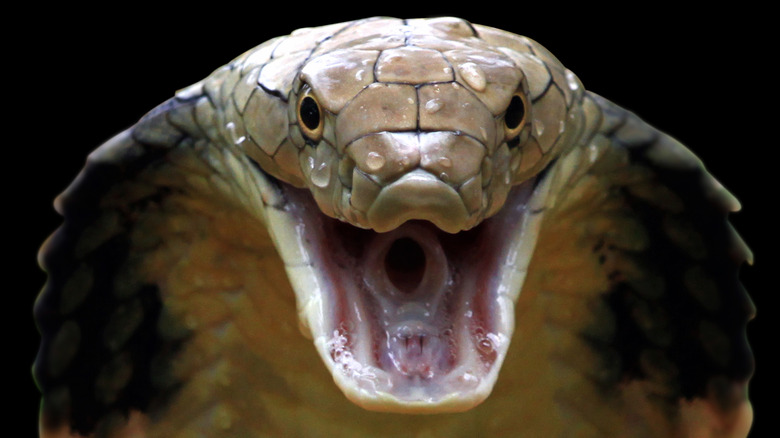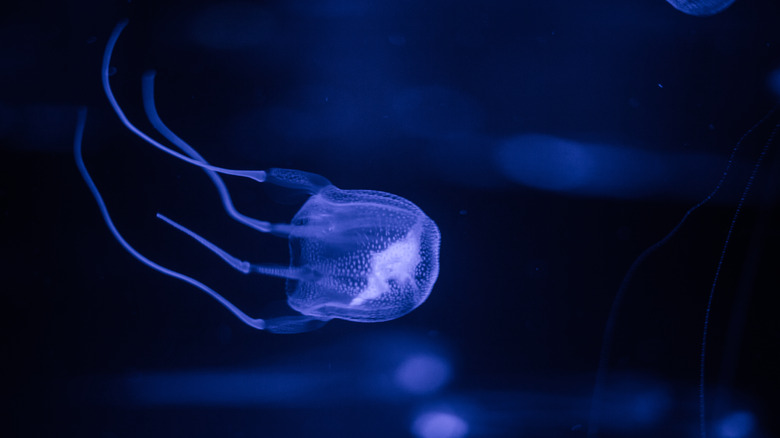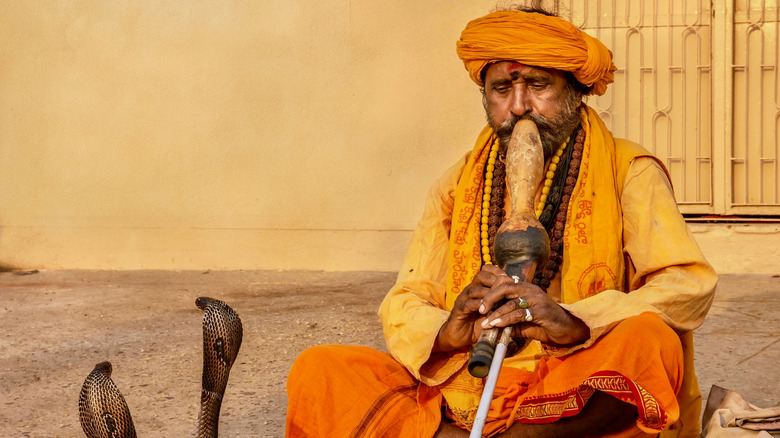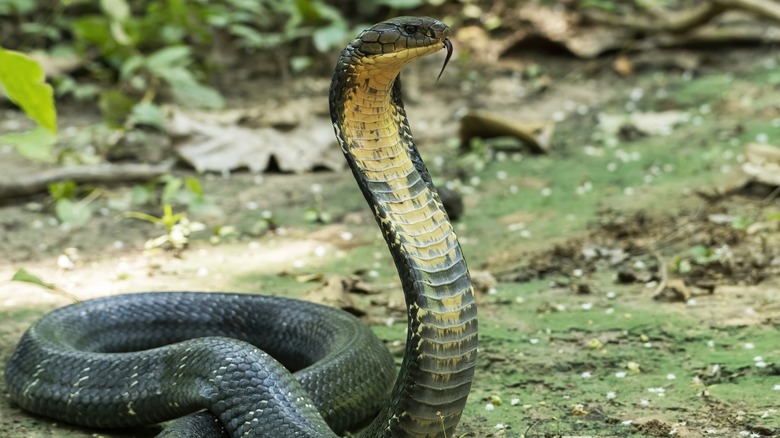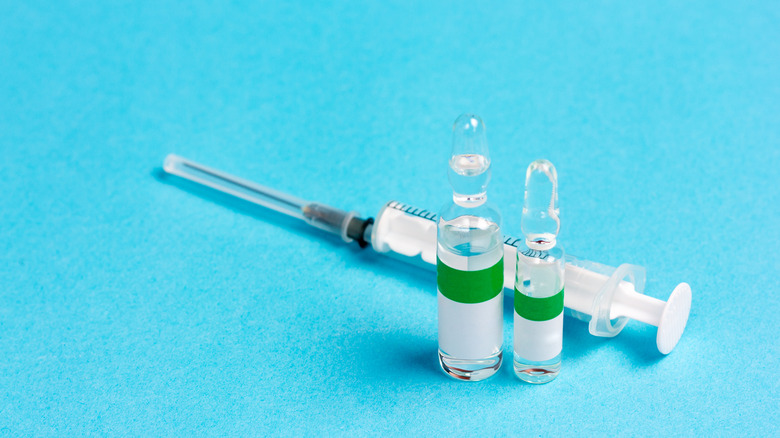What To Do If You're Bitten By A King Cobra Snake
King cobras are one of the giants of the snake world. They can reach over anywhere from 10 to 18 feet in length, making it the longest venomous snake in the world, and are one of the few snakes that can "stand up" — literally sit on their back end and rise vertically to look you straight in the eyes. Fortunately for most of us, the chances of meeting a king cobra in the wild are pretty slim. They live mainly in India, Southeast Asia, and parts of China, where they prefer forests, rivers, and mangrove swamps, though they sometimes venture into cities and towns. In the U.S., they are only found in captivity (per National Geographic).
Even if you do manage to accidentally cross paths with a king cobra, chances are it will just move away from you. Despite their scary appearance and bad reputation, king cobras tend to be shy and avoid people as much as possible. If you do happen to run into one, it will likely warn you before it strikes. They do this by flaring out their necks (or "hood"), hissing loudly (a sound that almost sounds like a dog's growl), and rearing up.
Despite its reputation and scary look, the king cobra usually won't attack unless it feels it has no choice. According to the Smithsonian's National Zoo & Conservation Biology Institute, that might happen when it's cornered or needs to defend itself, or has to protect its eggs.
There are plenty of other venomous animals in the wild
Here's a surprising fact for you: as scary as it looks, the king cobra is not the worst venomous snake out there. According to Live Science, the king cobra actually takes the No. 3 spot, behind the inland taipan and the coastal taipan snakes, both natives to Australia. The inland taipan produces an enzyme that speeds up toxin absorption in the victim's body, while the coastal taipan is so fast, you might not even see it or realize you've been bitten until the pain sets in.
The most toxic animal in the world is not even a snake. It's a jellyfish. The box jellyfish doesn't have the strongest venom, but it's still the most lethal animal. Once its tentacles inject venom, you'll experience cardiac arrest and death within minutes. The blue-ringed octopus is just as scary — it can kill 26 men with one bite and sorry, no antidote exists. In fact, if you want to stay alive, you should maybe stay out of the water. The cone snail, the Irukandji jellyfish, and the Dubois sea snake are all pretty deadly (per CNet).
Still, a king cobra is not something to laugh about. It can deliver enough neurotoxin with one single bite to kill 20 people (or an elephant) at once. So while it doesn't technically have the most powerful venom out there, it will often inject so much of it into its victim, a bite is very likely fatal (via National Geographic).
Can you survive a king cobra bite?
The general good news about bites from king cobras (and cobras in general) is that very effective antivenom exists. When treatment is given quickly, most patients recover well. It's sometimes possible to survive even if no treatment is given (or given late), because cobras sometimes have "dry bites," meaning they don't always inject venom (or don't have a chance to inject fatal quantities of it) when they bite. When looking into snake charmers who had been bitten, researchers found that 1 out of 3 had no signs of being injected with venom (per Medscape).
According to the Department of Clinical Toxinology of the University of Adelaide, fatality rates for untreated patients is 50-60%, which means about half of those bitten would survive even if they don't get to a hospital quickly. Other studies have shown a bit more somber findings. For example, a Thai survey reports that out of 35 people bitten by king cobras, 10 died (via Medscape).
Not everybody is that lucky, though. When tattoo artist and snake enthusiast Tyler Nolan was bitten by a king cobra snake, his reaction to the bite was so extreme, he had to be intubated at the hospital and received 12 vials of antivenom. In an intense YouTube video, he recounts how he eventually lost the tip of his finger, where the bite occurred, as a piece of the snake's fang had become lodged in the bone and was killing the tissue.
A king cobra's venom has powerful neurotoxic effects
A king cobra's venom causes everything from visual problems and vomiting to anticoagulation, muscle weakness, and respiratory failure (as reported via Live Science). The Division of Medical Toxicology at the University of California reports that the first neurological and neuromuscular signs appear within 15 to 30 minutes after a bite. (Pain starts right away.) Although not everybody experiences all symptoms, common ones include respiratory paralysis, paralysis of the palate, tongue and pharynx, convulsions, possible paralysis of the limbs and cervical muscles, and loss of consciousness. The tissue around the bite is often severely damaged and can quickly become necrotic. Infections, local edema, and swelling are also common.
Even when antivenom is administered, there's always the possibility that more serious symptoms will appear. If they do, respiratory assistance, intubation, fluid therapy, or other help might be necessary. Some potential complications can include impaired breathing and other neurological symptoms, acute renal failure that might require dialysis, and antibiotic therapy if there are signs of infection at the bite site.
When Tyler Nolan was in the hospital, his arm swelled up to a massive size, developing compartment syndrome (per the American Academy of Orthopaedic Surgeons), a large buildup of pressure that restricts blood flow in the muscles. When this occurs during a snake bite, doctors will sometimes make a cut the length of the entire arm (known as a fasciotomy) to help relieve the pressure, though this can cause many issues and affect the limbs later on (per Science Direct).
King cobra bite treatment
The bite of a king cobra can kill in as little as 30 minutes, so it's important to get to a hospital as quickly as possible. Before you move the victim, the Division of Medical Toxicology at the University of California recommends bandaging and immobilizing the limb, making sure it remains lower than the level of the patient's heart so the poison doesn't flow towards the heart. Ideally, the person shouldn't walk, either, as muscle contraction promotes venom absorption. If it's possible, carry the person or use a stretcher (per University of Adelaide).
If you live more than a few minutes away from a hospital, call in advance and let them know you're coming so they have time to secure antivenom. Because king cobras aren't native to the U.S., not every hospital might have enough antivenom ready to treat a bite, and they might need to get it from somewhere else. Calling in advance saves valuable time, and ultimately, a life.
Do not massage or clean the wound. Remove all rings or anything that might compress the skin as swelling starts (via University of Adelaide). You can cover it with a bandage but not tight enough to affect circulation. You should also be prepared to do provide mouth to mask resuscitation if the victim develops trouble breathing.
